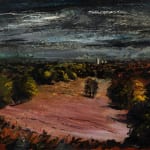John Piper
‘[Romantic art] is the result of a vision that can see in things something significant beyond ordinary significance: something that for a moment seems to contain the whole world; and, when the moment is past, carries over some comment on life or experience beside the comment on appearances.’ (J. Piper quoted in D. Fraser Jenkins and H. Fowler Wright, The Art of John Piper, London, 2015, p. 195).
Tasked with recording bomb-damaged buildings and abbeys during the 1940s, Piper found a somewhat lighter relief depicting country manors and estates across the country. The extreme architecture and secluded locations excited Piper, and his paintings and drawings demonstrate a masterful ability to capture the grandeur and beauty of a setting alongside a sense of drama and emotive connection within each scene. With war threatening destruction of these historic sites, this was often an elegiac feeling, conveyed by Piper’s use of bold skylines and dark tones of blues, reds, and ochre, as seen in his Windsor Castle and Renishaw Hall, Derbyshire paintings. Alongside contemporaries Graham Sutherland and Henry Moore, these distinctive poetic and literary themes and painterly techniques became grouped as ‘Neo-Romanticism’. Piper never referred to himself with this title, instead noting his works as ‘contemporary romantic paintings’, informed by the powerful landscapes of artists such as J.M.W. Turner and J.S. Cotman, evolving this into an individual experience of a particular place.
In Highclere Park is an excellent example of Piper’s landscape painting from this period. Here, Piper dramatically overlooks the estate at a high clearing from a footpath (known now as Brenda Parker Way). Shadowy woodlands surrounding the estate and a threatening sky imbue the painting with similar theatrics and intensity. Layers of blues and greys provide depth across the entire scene while the central fields and the treetops are flooded with a dreamlike, dusky pink and yellow light. Highclere Castle (used during this time to house evacuees from London) is just visible in the distance suggested by a few simple brushstrokes. Layers of colour and paint have been so energetically applied to the board throughout, further highlighting Piper’s intensity and passion for the landscape he was depicting.
Owned by Howard Bliss in the 1950s, In Highclere Park was loaned to the Manchester City Art Gallery and exhibited at the Leicester Galleries as part of Bliss’ wider collection, where it was purchased by Major Edwin Ody Kay. Kay’s art collection included works by Walter Richard Sickert, Sir George Clausen, Augustus John, Tristram Hillier and Paul Nash with portraits by William Roberts and Stanley Spencer. Since Kay’s later sale at Christie’s, the painting has remained in the same private family collection for over fifty years. Highclere Castle is well known today as the main setting for period drama Downton Abbey.
Provenance
Howard Bliss.Major Edwin Ody Kay (purchased from Leicester Galleries exhibition).
Christie's, London, 19 March 1971, lot 61, where purchased by the present owner's father.
Exhibitions
Manchester, City Art Gallery, on loan.London, Leicester Galleries, From Gainsborough to Hitchens: Howard Bliss Collection, January 1950., ex. cat.
Sheffield, Graves Art Gallery, Modern Pictures from Major E. O. Kay's Collection, February 1953.



